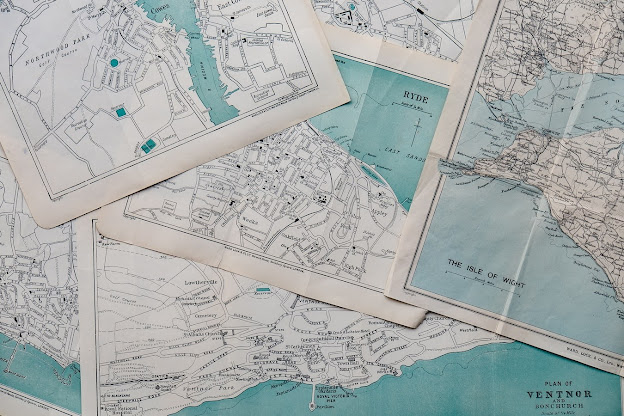Maps (Part 2): Analogies
While metaphors and analogies overlap as literary devices and mental strategies, their functions may be different. A paper studies how engineering teams approach design problems. Researchers find that while metaphors predominate in the early stages of problem framing to help with interpretation, analogies are used more commonly in the later phases of concept generation for illustration. Metaphors used in framing affect the thought process leading to possible solutions. For example, if “design” is seen as a journey or exploration, images of paths are created. If the problem is viewed as a search instead, lists of ideas to be selected tend to be generated. In analogies, ideas with similar or parallel features are retrieved from memory. Life as a journey brings analogies of a map with detours and shortcuts, roadblocks, dead-ends, signposts, and other symbols to illustrate guides and obstacles to life.
One of the most obvious examples of maps as analogies is our use of literal maps. We are dependent on maps, whether physical or virtual, along with mental cognitive mapping, to orient ourselves in everyday tasks: “The urge to map is a basic, enduring human instinct” (Blaut, 2003).
All maps have a context and purpose that determines how they are or should be used. They all select data to simplify a complex temporal world. Whether geographical, political, meteorological, or schematic like subway maps, a map filters and displays only the specific portion of knowledge it is designed for. It is therefore always incomplete and flawed from actual reality.
The oldest map we have is one of the stars in the skies, not the land on which we live. Since then, we can now hold a map of the whole world in the palm of our hand—the Google Maps app. In his book Solitude, Michael Harris equates this app with the map that Main Herr in Lewis Carroll’s Sylvie and Bruno spoke of. “We actually made a map of the country, on the scale of a mile to the mile.” More than just a navigational aid, the Google app accentuates attacks on solitude. “It insists that you will never be lost, you will never slip away. With it, we have lost the “lost-in-the-field” wonders by being “lost”, literally or metaphorically.” Moreover, by showing us on the map what sites we seem to prefer based on inventory of previous personal choices, our private mental maps of what is meaningful are skewed by monetized external influences. We can turn into unthinking navigational zombies and ignore our internal way-finding skills. The joy of wondering while wandering is downgraded for the sake of efficiency—the fastest, shortest or cheapest route is king, and we submit ourselves to it.
Another issue is maps as analogous atlases of areas of knowledge.
“An Area of Knowledge describes or maps a particular section in that atlas. Knowledge areas overlap and often compete. But can ethics describe, or map, the territory of the natural world? And how can the Natural Sciences map the territory of Faith and Worship? The map now is of the wrong territory. It isn’t that the map is wrong, it is that we have chosen to use it for a purpose it was never intended—such as using a London subway map to navigate the streets of London. We need the right tool for the right job.” (Howard Burton blog, 02-11-20)
Here, I want to challenge the premise that it is not possible, or ever desirable, to cross-link maps for unintended purposes. Genesis in the Bible addresses (maps) the question of who and why of creation, not how. Therefore it is correct to not scrutinize it from a scientific perspective (map of a different area of knowledge). It would be using the wrong map. However, if all Truth is His truth, we should find analogous language or ideas that are consistent or similar rather than being contradictory theories.
According to the Bible, God spoke (pure energy), from nothing (no mass) the universe came into being. Stars and planets preceded life, water before land, simpler life before humanity. Language and naming (conceptual thinking) was a human ability emphasized initially, yet with only “speech” as the early form, not writing that developed later. Humanity was to spread throughout the earth, which we did in record time. But we had to endure hardships tilling the land. As Harari and others mentioned, the Agricultural Revolution was not the panacea we once thought it was. Human dispersal after the flood created different ethnic-cultural-tribes and nations, not the concept of “races” that is a modern political unscientific categorization. The sequence and character of developments progressing over time as described in the Bible fit current scientific theories of universe, life, and human civilization. Our God creating us in His image, that of a community of Trinitarian love, fit a map of the narrative of Homo Collaborators better than any other human-constructed myth.
Maps as analogies can assist in philosophical, psychological, and physiological discussions. Examples include our total disorientation and difficulties in using existent mental maps after a disaster or catastrophe, or how the mind and consciousness develop from brain neurocircuitry. Meditate on the concept of using maps as analogies, and many more serendipitous interesting insight may emerge.
***
References:
Blaut, J.M., Stea, D., Spencer, C. and Blades, M. (2003) “Mapping as a Cultural and Cognitive Universal,” Annals of the Association of American Geographers, vol. 93, no. 1, p. 165–185.
Hey, J et al., (2008) Analogies and Metaphors in Creative Design, International Journal of Engineering Education, Vol 24, No. 2, pp 283-294, 2008
Jost, Stefan (2016) How Maps Shape our Minds, blog post, March 1,2016




0 comments